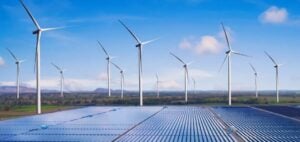rPlus Energies starts construction of the Green River Energy Center, a large-scale project combining solar production and energy storage.
This energy center, located in eastern Utah, will have a capacity of 400 megawatts (MW) of photovoltaic production and a battery storage system of 1,600 megawatt-hours (MWh).
The project is part of a national drive to increase the integration of renewable energies into the energy mix, while guaranteeing a stable electricity supply for consumers.
The Green River Energy Center stands out for its scale, combining both solar power generation and a storage system to compensate for variations in production, thus ensuring a constant supply of electricity.
This type of hybrid project is becoming a model to follow in the industry, where demand for reliable, low-emission solutions continues to grow.
Strategic partnerships for efficient implementation
The project involves several major players in the energy and construction industries.
Sundt Construction, a contractor renowned for its work in the mountainous American West, is responsible for engineering and construction.
Tesla is supplying the batteries used for storage, while EliTe Solar is responsible for the photovoltaic modules.
These collaborations reinforce the project’s ability to meet technical requirements and offer solutions that are both robust and innovative.
PacifiCorp, the main electricity supplier in the region, will be the purchaser of the energy generated, under a Power Purchase Agreement (PPA).
This partnership is essential to ensure a sustainable and stable return on investment over the long term.
The key challenge for PacifiCorp is to guarantee optimal management of peak demand, thanks to this energy, which is stored and distributed according to need – an increasingly crucial requirement in the sector.
Local and regional economic benefits
The Green River project is not only a technological breakthrough, it will also have a significant impact on the local economy.
Around 500 jobs will be created during the construction phase, mainly by local workers.
In addition, the project is expected to increase tax revenues in Emery County, where the site is located, helping to fund public infrastructure and develop community services.
These jobs and tax benefits represent an opportunity for Utah’s rural areas to benefit directly from investment in the energy sector.
For Utah, this project is part of an economic diversification strategy, focusing on renewable energies and creating job opportunities in a booming sector.
The Green River Energy Center is a perfect example of how large-scale energy projects can be integrated into local economies, while promoting long-term growth.
Outlook for the US energy sector
At a time when energy players are having to adapt rapidly to new regulatory requirements and the challenges posed by resource management, projects such as the Green River Energy Center demonstrate that solutions combining energy production and storage offer promising prospects.
In the United States, the adoption of these technologies is becoming more widespread, with several similar projects already underway or planned in different states.
The US energy sector must now reconcile growing electricity needs with the need to reduce emissions and guarantee a stable supply.
Energy storage solutions provide just such a response, ensuring continuity of supply even when solar production is limited, particularly at night or during periods of low sunshine.
With projects like Green River, energy producers and distributors now have the tools they need to ensure the transition to less carbon-intensive energies, without compromising the reliability of power grids.






















